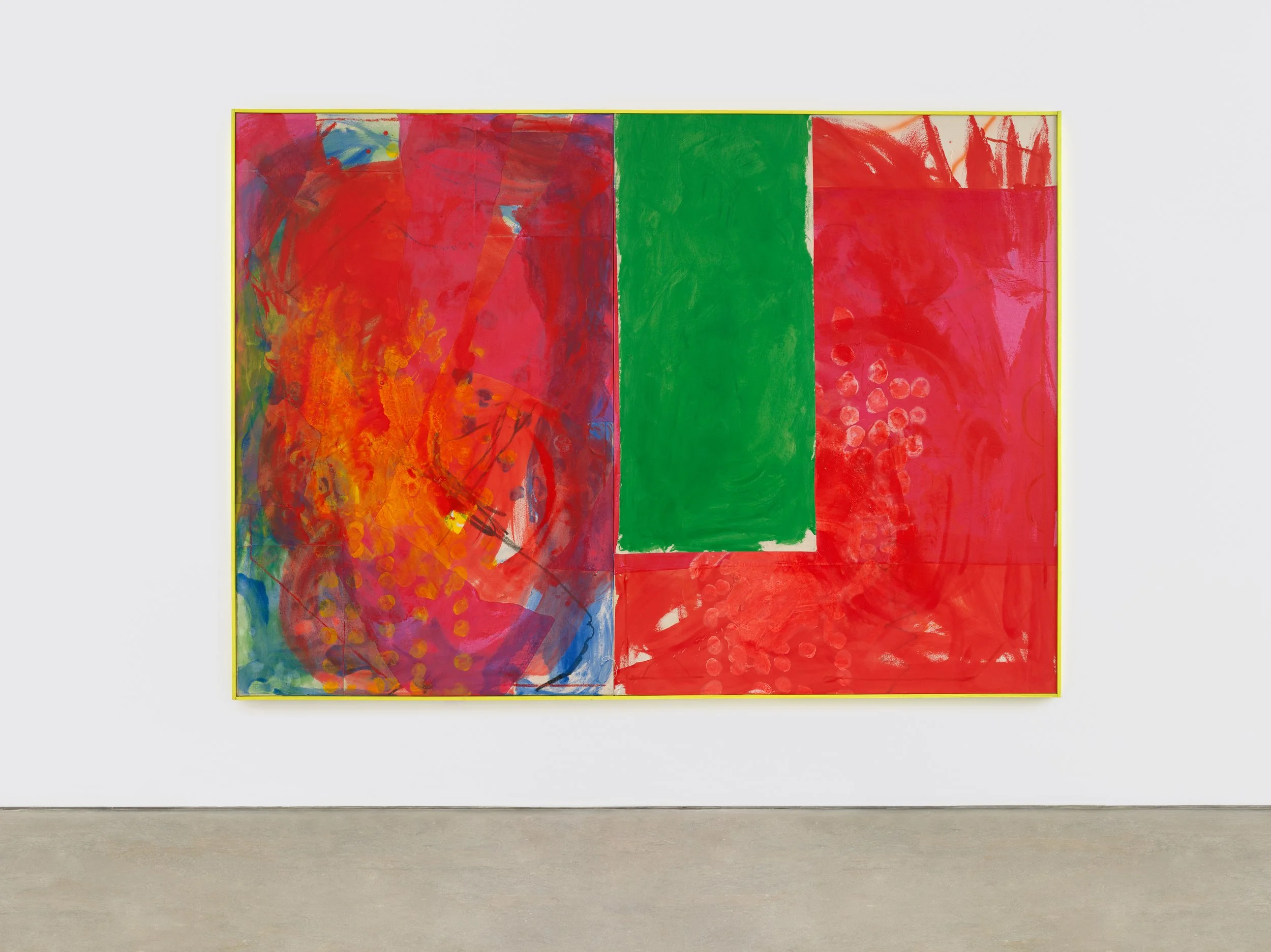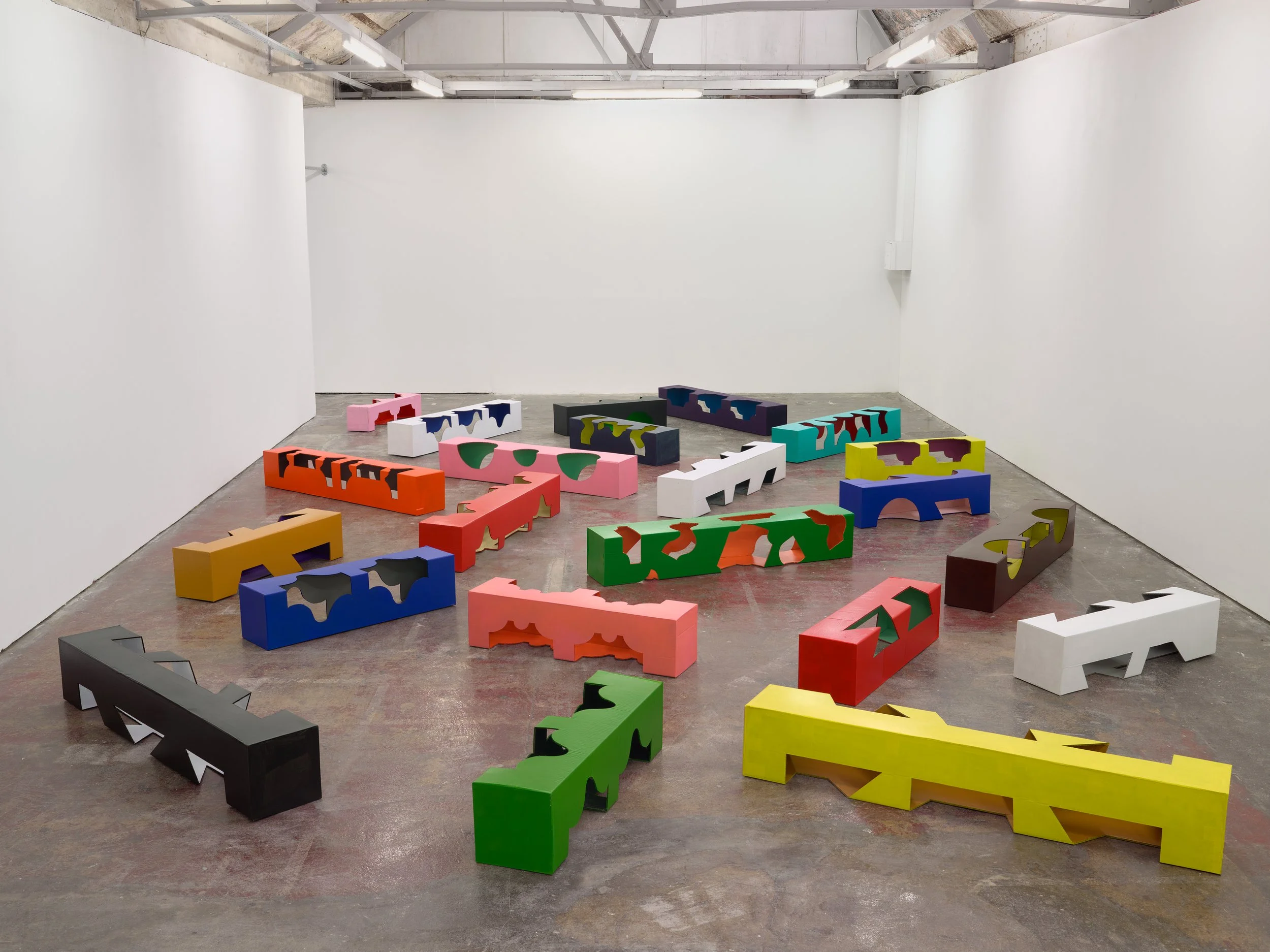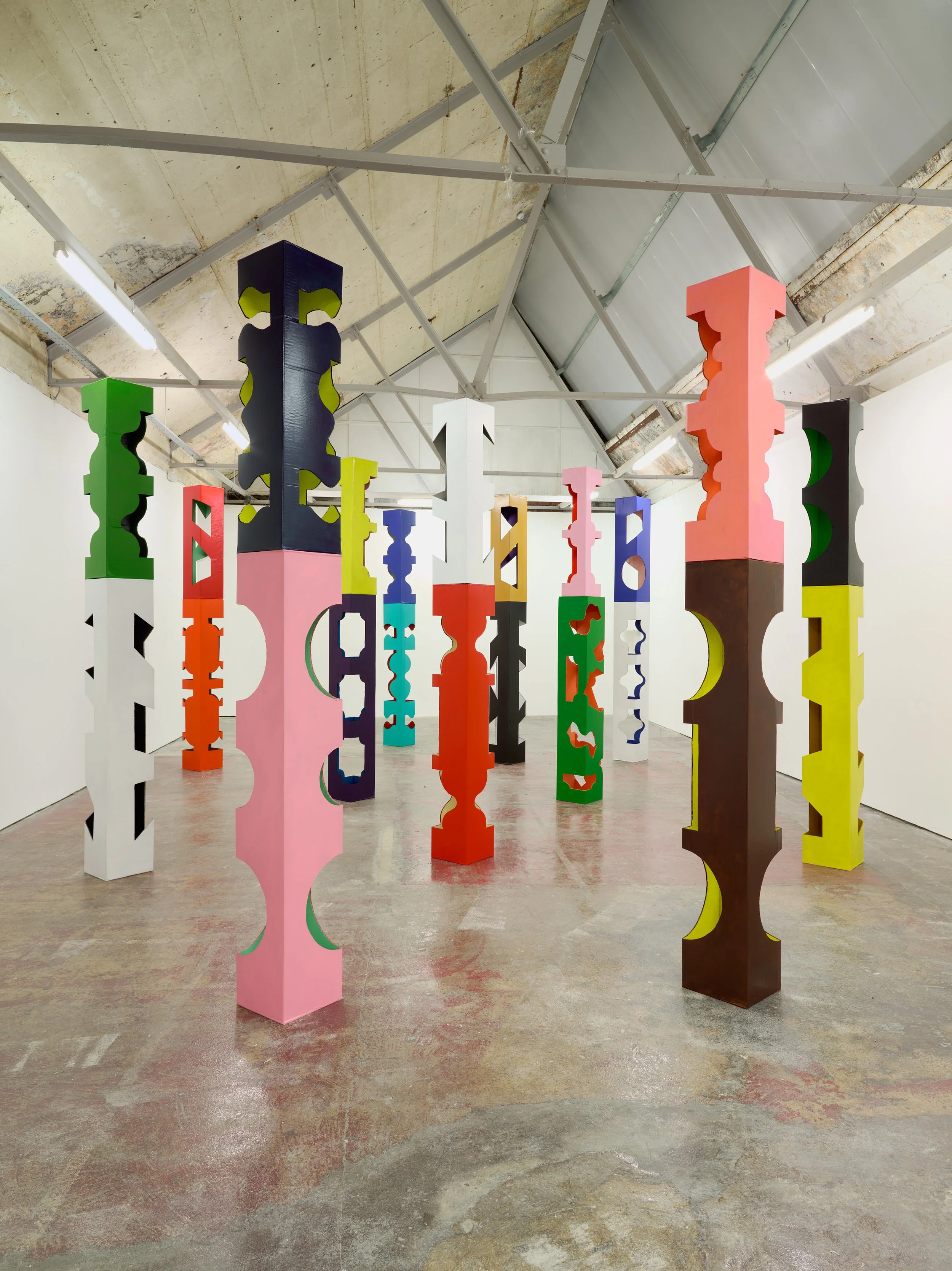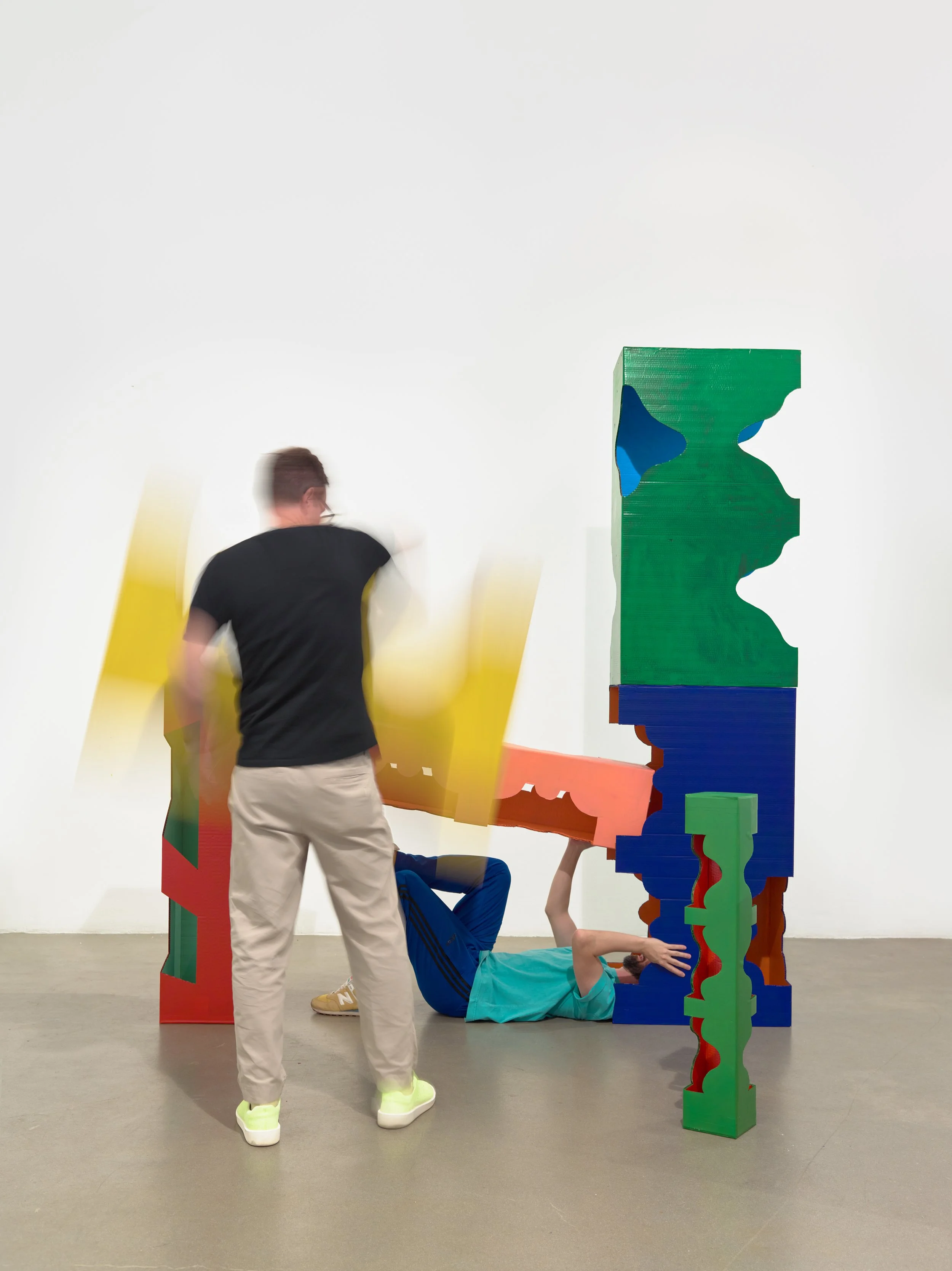Jonathan McCree
Jonathan McCree: I am a multi-disciplinary artist with a playful and experimental approach to making art. I work with painting, sculpture, film and performance. Collaboration is often a big part of my practice and in recent years I have worked with dancers, film makers, musicians, architects and designers. When I start on any project, I’m never clear in my mind about where I will end up. I think of the uncertainty as energy. This is most apparent to me when I collaborate. In these situations, I like to give up something of what I think I might know in order to see where someone else might take my ideas. Materiality and structure are often main considerations and my art uses an abstract visual language. I do this because I need a language, which I feel gives me room to invent and play. My goal is to think about the spaces we navigate on a daily basis. I like to make objects, which challenge an audience to discover a way to inhabit a visual or physical environment. I am interested in the prospect of an adjustment in behaviour in the present as a way to embody and instigate a future. I’m not proposing a kind of utopian modernism, or a better world. It’s more about pointing out alternative ways of being and realities. Most recently I made sculptures from cardboard, which were modular and light enough to be moved easily. One of my thoughts was to give up control over installing the sculpture by inviting an audience to create their own arrangements. Both this strategy and the process of collaboration make the work a little bit less about me and what I think I know and feel. I like this stepping back, a playful giving ground.
1. Hi Jonathan, please tell us about your background and how it has influenced your professional career?
I studied the History of Art at the University of Sussex. Looking back, this feels like a surprising choice because I have always used making as a way to think. I suspect that having spent a year at art school on a Foundation course, I didn’t feel ready to embark on a full time practice. I think I also wanted to be in an environment, where there were people doing other things; science, languages and the broader humanities. But I think my interest in history has given me a way to think about my reference points and how I might want what I make to sit in relation to other things. The discipline and study of art history initially made me quite self-conscious about making my own work, which was something I had to work through. Years spent writing objectively in the third person was also a barrier I had to break, and now I really enjoy first person and more embodied points of view.
2. You are a multidisciplinary artist working with painting, sculpture, installation and video.
How do you begin, and what is your process of each medium? One thing leads to another in an instinctive way. Although I often work on clearly defined projects and sometimes site specific work, I am usually continuing my thoughts from what came before. I find that ideas that I may have had 10 years ago, will circle around and find new forms and contexts. I draw a lot. I like to take a drawing book somewhere and draw what I find. This is a way to organize my thoughts rather than to render an image. I often don’t look at the drawings much once I’ve done them. They stay with me mostly as a set of physical memories, which I will find useful later on. It also feels important to take in something of the world outside of my studio. When I start on any project, I’m never clear in my mind about where I will end up. I think of the uncertainty as energy. This is most apparent to me when I collaborate on a project with other artists; dancers, film makers, architects, musicians. In these situations, I like to give up something of what I think I might know in order to see where someone else might take my ideas. This is often about learning each other’s creative language as a way to discover something. My recent work with sculpture was a way of taking this feeling of uncertainty into a gallery space. A painter’s studio practice (mine at least) is often beset by a certain anxiety around finding solutions that work or sit right. I became quite frustrated by this process and at the same time desired to make something that wasn’t necessarily expressing something but was more receptive towards and perhaps reflective of it’s environment. I didn’t want to just repurpose the expressive language of my paintings. Instead, I wanted to make something that doesn’t require an expressive gesture for its energy, but rather a kind of sensitivity. It occurred to me that this sensitivity needed three-dimensions, it needed to share a space with an audience to create a more tangible interface with the environment. The sculptures I made were modular and light enough to be moved easily. One of my thoughts was to give up control over installing the sculpture by inviting an audience to create their own arrangements. I wanted to take the uncertainty out of the studio and put it in the gallery, and take a break from the anxiety. Both this strategy and the process of collaboration make the work a little bit less about me and what I think I know and feel. I like this stepping back, a playful giving ground.
3. You mentioned ‘’Anything can be painting.’’ How can a sculpture or film be painting from your perspective?
This is about how I position myself in the world personally, literally my way of seeing and being in the world. Painting is a prism I use instinctively to see things. My thought that anything can be a painting isn’t meant as a specific ontological rearrangement. In the English language, the word ‘painting’ can be either a verb or a noun. When I paint, the painting collects time unto itself in an accumulation of marks across a surface. The illusion is that everything happens at once. Under this illusion, a painting is an object. I prefer to think of paintings as active, dynamic, speaking subjects, and painting as an embodied way of thinking about and participating in the world.
4. Why did you choose cardboard and paper materials for your sculptures? What does it mean to you?
Some years ago, I lived on the outskirts of the Everglades National Park in South Florida, with the artist Richard Warholic. He used wood to make furniture, which he painted. I worked with him and learnt how to build structures from wood. In early 2020 during the first Covid lockdown in London, I had a lot of cardboard packaging in my studio. On an impulse I decided to make a small
cupboard out of cardboard. I used the same principles as if it was wood and found that it obeyed the same kind of structural logic. I liked making something, which looked familiar and as though it could be used, but was in fact quite non functional because it was half the size of a useable cupboard and made of non durable material. It had a strong sculptural feel. I just kept going, not quite knowing where this was leading. Next came some mini chairs and benches. The problem was that I kind of knew where it was headed and the strong sense of domesticity didn’t really interest me. I wanted something more architectural, where the outcome was less clear or resolved. This is when I started thinking of making modular components, playful building blocks if you like. The cardboard was to hand and easy(ish) to cut with knives I already had. The sculptures were also light and easy to move, which created the possibility of moving and re-installing an exhibition to create different, evolving iterations. The lightness and fragility of the cardboard made it possible to work with performers. I made one short film of a dancer falling into a sculpture, allowing the form to take his weight and cushion the fall and at the same time making something new as the dancer’s body squashed and indented the sculpture. What has become apparent recently, is how I can re-purpose and re-cycle the sculptures, I’ve started cutting them, folding them differently and making new objects.
5. You have been working on abstract formats in painting and sculpture; Why abstraction?
I grew up with parents who were members of a strict, fundamental, Christian organisation called Christadelphians. It felt important to me quite early on to be working with a visual language in which, as far as possible I was free to play and invent. I have memories of my parents: the white cube church and the community that they belonged too, and how I wanted to replace that set of memories, replace that sterile environment. You imagine a church environment to be full of meaning or ecstasy, or whatever religious spaces are supposed to contain. I wanted to replace the sterility I experienced, with daydreams. To replace the emptiness with something more fantastical, something that my imagination could inhabit. I think sometimes my own memories play out in the colors and their relationships. I’m instinctively aware that it has to be a brown next to a particular shade of orange, which I think comes from a memory that I can’t quite pinpoint. That makes me wonder whether the memories are abstract, maybe they are about emotions and desires more than specific narratives. Although it is obvious to me that abstraction has its own form of narrative, I need a language that I feel gives me space. I wonder if it is about making new kinds of sense and configuring possibilities. If I think about the furniture that I first made, we all know what the future looks like if it is made up of chairs and cupboards. Whereas, with the structures of ‘High Folly’ if you extend them into the future, you don’t know what that future might look like. Maybe it requires a subtle adjustment of behavior in the present to embody that, to instigate that future. I’m not proposing a kind of utopian modernism, or a better world. It’s more about pointing out alternative ways of being and realities.
Working with the dancer in ‘High Folly’ was a way to do that, touching on something that isn’t quite real, but seems like it could be. Through the movements in their bodies, dancers are almost trying to articulate a desire to understand something. It highlights the tensions of fiction and reality. It’s like a photograph. We think about photographs recording memories, but in actuality they destroy them. I find that childhood photographs erase any sense of the memories I may have had, and the object starts to stand in for that memory. I think that’s one of the issues with abstraction as well, it constantly alludes to something just beyond reach. You’ve destroyed a set of possibilities by making it concrete and the form then represents impossibility. It’s almost the failure of abstraction, which is a beautiful failure if you like.
6. Can you please explain about High Folly and Swing videos?
Both videos were made with Joe Walkling and Jonathan Goddard and were part of my solo show ‘High Folly’ at Sim Smith Gallery, London. The show was scheduled for a time when it was apparent that London would be in lockdown because of covid. I had originally planned to work with Jon and Joe on a live performance within the gallery installation, and when this became impossible we decided to make a film. When I thought about the film ‘High Folly’ it felt important that we weren’t making some kind of substitute for live performance. I wanted something that could only exist as choreography in a film, and it was conceived from the outset as something to be experienced on a screen and probably on line. Hence the spinning choreography, which was edited to create this impossible suspension in the air. I have collaborated with Joe and Jonathan over 5 years on a number of projects and we often talk together about how a body, usually of a dancer, might inhabit a visual or physical space. As a choreographic gesture, I found Joe’s suspended spinning a rather beautiful way to inhabit the sculpture and a curiously poignant metaphor. I think of ‘Swing’ as more formally driven. I was thinking about how the rope articulates an endlessly evolving line, which is always defining a space anchored and prescribed by the body. It put me in mind of an unstable version of Leonardo’s Vitruvian man. Again, I feel it addresses the question of how a body inhabits space.
7. Describe a real life situation that inspired you.
A few years ago, I lived on the outskirts of the Everglades in South Florida, with the artist Richard Warholic. This experience and Richard’s friendship have been hugely important in my life and practice. The light, space and colour I experienced there were radically different to anything I had encountered before. Growing up in the relatively claustrophobic spaces of England, it was a shock and a liberation to encounter the vast Floridian landscape. I worked in an outdoor studio and lived in a small and very basic homestead cottage. Driving and sometimes cycling in the Everglades there are so few reference points and so much apparent emptiness that it can be hard to orientate yourself. I went cycling on one occasion and became quite disorientated. As I peddled harder and harder, I felt like I was getting nowhere, standing still. It can be quite frightening and local myths tell of how in moments of vulnerability the space can enter you and send you mad! At certain times of day however, the endless openness gives way to astonishing displays of light and atmospheric color.
8. What is your next project?
I am working with fabricators now, exploring different ways to make my sculpture. I want to see the sculpture outside, so I am working with more durable materials like steel, aluminum and ply wood. I am also working on a new film with Jonathan Goddard and Joe Walking.
We are editing the footage, which was shot during my recent exhibition at the Foundry Gallery, London. I am also keen to explore the social and performative potential of the cardboard sculpture and I am working with a local primary school on a series of workshops using the sculptures as props. I’m not sure yet what will emerge from this; another film, some photographs or a permanent installation.













